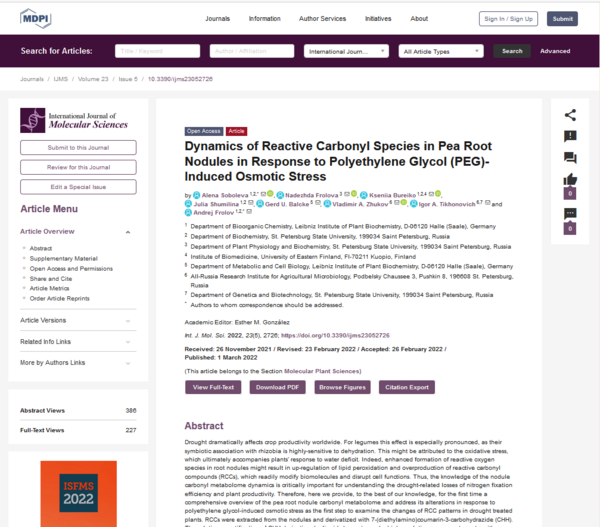Drought stress reduces nitrogen fixation in legumes.
Drought causes a dramatic yield loss in all crops. Legumes in particular are extremely sensitive to water deficit, leading to reduced nitrogen fixation by their symbiotic partners, the rhizobia. Scientists assume that drought stress induces the formation of reactive oxygen species in the root nodules, which leads to an overproduction of reactive carbonyl compounds. These compounds include numerous saturated and unsaturated aldehydes, ketones and oxocarboxylic acids, which attack proteins and nucleic acids with great reactivity.
For the first time, IPB scientists have investigated the carbonyl metabolome of pea root nodules and demonstrated first correlations between carbonyl metabolism and drought-induced losses in nitrogen fixation. They could show that carbonyl production under water deficiency leads to up- and down-regulation of specific carbonyl compounds and finally to a blocking of porphyrin biosynthesis. Porphyrin, a complex compound with an iron atom, is the main component of leghemoglobin, which is produced by the plant to absorb any excess oxygen within the nodules. It protects the extremely oxygen-sensitive bacterial nitrogenase from loss of activity. The lack of porphyrin production under drought stress thus impairs these protective effects on the nitrogenase. Consequently, the enzyme permanently loses its catalytic ability to reduce molecular nitrogen to ammonia.
Cleaving the triple bond in the N2 molecule by nitrogenase requires a lot of energy. To convert a single nitrogen molecule, 16 ATP and four NADH molecules are needed. This energy is supplied by the plant in form of citrate cycle intermediates, such as succinate and malate, which are transported to the root nodules. Rhizobia then use these compounds to produce the required energy equivalents for nitrogen fixation. The scientists speculate that this plant carbon flow supporting symbiosis could be interrupted under drought stress in order to prioritize plant survival. For the experiment, plants were put under osmotic stress by using polyethylene glycol – a condition simulating water scarcity. A confirmation of the results with topsoil is still pending.



